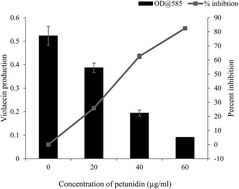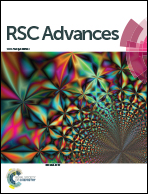Petunidin as a competitive inhibitor of acylated homoserine lactones in Klebsiella pneumoniae
Abstract
Most of the bacterial species communicate with each other through a mechanism called Quorum Sensing (QS) to regulate their phenotypic characteristics. Therefore interrupting the bacterial communication is an attractive strategy for the management of bacteria. The present study aims to identify a novel QS-inhibitor and to investigate its QS inhibitory activity against K. pneumoniae, an opportunistic food borne pathogen. Initially, 43 phytochemical compounds were docked with LasR receptor protein and the compound exhibiting the highest score was further screened for its effect on QS regulated phenotypes. Molecular docking analysis revealed that out of 43 active components, petunidin exhibited the highest ligand binding with a dock score of −8.38 kcal mol−1. In vitro study showed that petunidin at its sub-MIC level, reduced exopolysaccharide (EPS) production up to 64.41% and biofilm formation up to 67.66% which was more evident from scanning electron microscopic (SEM) and confocal laser scanning microscopic (CLSM) imaging. Synergistic activity of conventional antibiotics with petunidin enhanced the susceptibility up to 90.69%. In addition, simulation studies predicted that QS inhibitory activity of petunidin occurs through the conformational changes in the 3D structure of LasR receptor protein and petunidin complex. Our findings suggest that petunidin can act as an effective competitive inhibitor for signaling compounds towards LasR receptor pathway and can serve as a novel QS-based antibacterial/anti-biofilm agent for the management of food borne pathogens.


 Please wait while we load your content...
Please wait while we load your content...